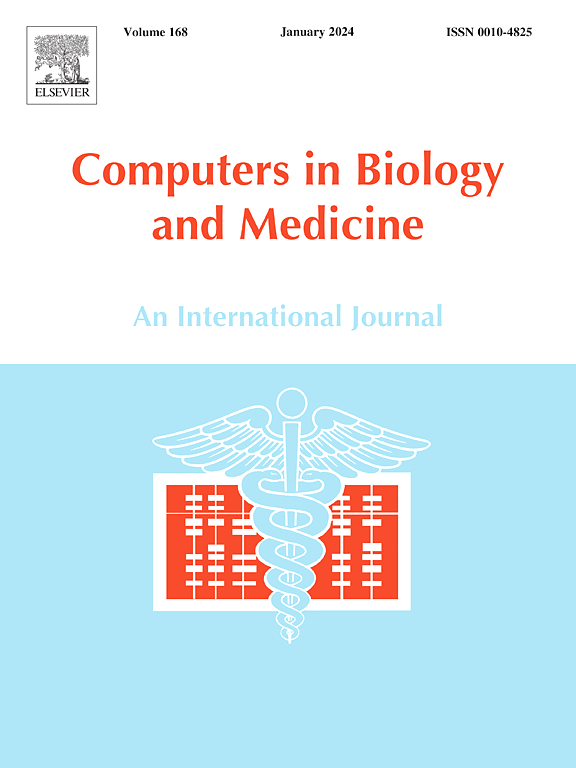具有红细胞压积粘度的电渗透非牛顿混合纳米流体(血液)通过多孔重叠不规则狭窄动脉的生物医学模拟
IF 6.3
2区 医学
Q1 BIOLOGY
引用次数: 0
摘要
受到心血管疾病治疗中药物输送治疗可能性的启发,作者的目标是研究非牛顿混合纳米流体通过具有两种狭窄类型(i)不规则和(ii)重叠的动脉电渗透流动期间的血流动力学现象。在目前的工作中,作者将Ag - TiO2作为混合纳米颗粒掺入血液中,并利用萨特比流体来代表血液的非牛顿性质。在这里,作者的目标是通过考虑由于血液中存在红细胞而导致的血细胞比容依赖性血液粘度,使模型更符合现实生活情况。在提出的模型中,作者分别在流动的径向和轴向上加入了磁场和电场。此外,作者还考虑了粘性耗散、化学反应、焦耳加热、热辐射和身体加速度对血流特性的影响。该模型由非线性偏微分方程控制,这些偏微分方程由连续性、动量、能量和浓度方程组成,具有合适的边界和初始条件。作者利用“显式有限差分法”,借助MATLAB“R2023a”软件,得到了壁面剪应力、流动阻力、努塞尔数、舍伍德数、浓度、温度和速度的图形结果。此外,在本工作中,绘制了各种血流动力学参数的流线。从所提出的工作结果中可以注意到,Ag−TiO2/血流速度支配Ag/血流速度。纳米颗粒体积分数每增加1%,不规则狭窄动脉的血流速度比纯血(基底液)提高41.08%,重叠狭窄动脉的血流速度比纯血(基底液)提高37.93%。此外,不规则狭窄比重叠狭窄的壁面剪应力值更大。此外,作者还用以前的文献验证了他们的发现。目前的模拟在生物医学工程、肿瘤和脑动脉瘤的诊断、血凝块的提取和磁性靶向药物递送等方面具有广泛的应用。本文章由计算机程序翻译,如有差异,请以英文原文为准。

Biomedical simulations of electroosmotic non-Newtonian hybrid nanofluid (blood) with hematocrit viscosity through a porous overlapping irregular stenosed artery
Inspired by the therapeutic possibilities of drug delivery in cardiovascular disease management, the authors’ objective is to investigate the hemodynamic phenomenon during the electroosmotic flow of non-Newtonian hybrid nanofluid through an artery featuring two types of stenosis irregular and overlapping. In the present work, the authors have incorporated as the hybrid nanoparticles in the blood and the Sutterby fluid is utilized to represent the non-Newtonian nature of the blood. Here, the authors’ objective is to make the model more realistic for real life situation by considering a hematocrit-dependent blood viscosity which is due to the presence of RBCs in the blood. In the proposed model, the authors have incorporated the magnetic field and electric field in the radial and axial direction of the flow, respectively. Additionally, the authors have taken into account the effect of viscous dissipation, chemical reaction, Joule heating, thermal radiation, and body acceleration on the blood flow characteristics. The present model is governed by the non-linear PDEs’ constituting continuity, momentum, energy, and concentration equations with suitable boundary and initial conditions. The authors have utilized the ’Explicit Finite Difference Method’ with the help of MATLAB ‘R2023a’ software to get the graphical results for the wall shear stress, flow resistance, Nusselt number, Sherwood number, concentration, temperature, and velocity. Further, in the present work, the streamlines are plotted for various hemodynamic parameters. It is noticed from the results of the proposed work that /blood flow velocity dominates the velocity of /blood. It is also observed that while increasing the nanoparticle volume fraction of 1%, the blood flow velocity rises 41.08% for the irregular stenosed artery and 37.93% for the overlapping stenosed artery compared to pure blood(base fluid). Moreover, the wall shear stress has higher magnitude for irregular stenosis than overlapping stenosis. Additionally, the authors have also validated their findings with the previous literature. The present simulations have a broad range of applications in biomedical engineering, diagnosis of tumors and brain aneurysms, extraction of blood clots, and magnetic targeted drug delivery.
求助全文
通过发布文献求助,成功后即可免费获取论文全文。
去求助
来源期刊

Computers in biology and medicine
工程技术-工程:生物医学
CiteScore
11.70
自引率
10.40%
发文量
1086
审稿时长
74 days
期刊介绍:
Computers in Biology and Medicine is an international forum for sharing groundbreaking advancements in the use of computers in bioscience and medicine. This journal serves as a medium for communicating essential research, instruction, ideas, and information regarding the rapidly evolving field of computer applications in these domains. By encouraging the exchange of knowledge, we aim to facilitate progress and innovation in the utilization of computers in biology and medicine.
 求助内容:
求助内容: 应助结果提醒方式:
应助结果提醒方式:


